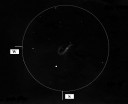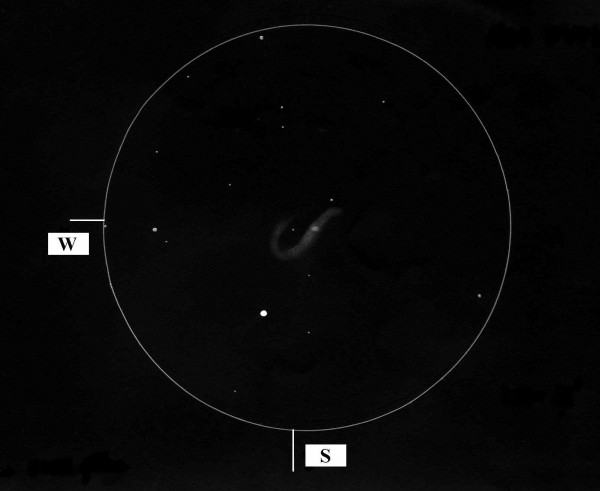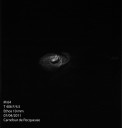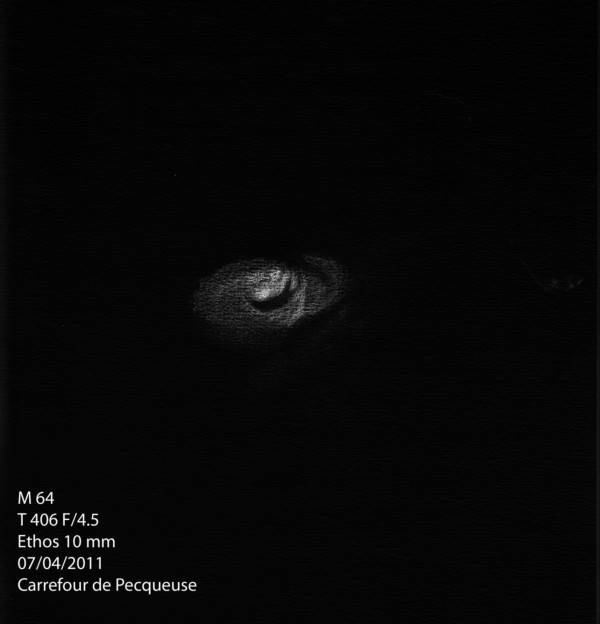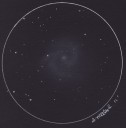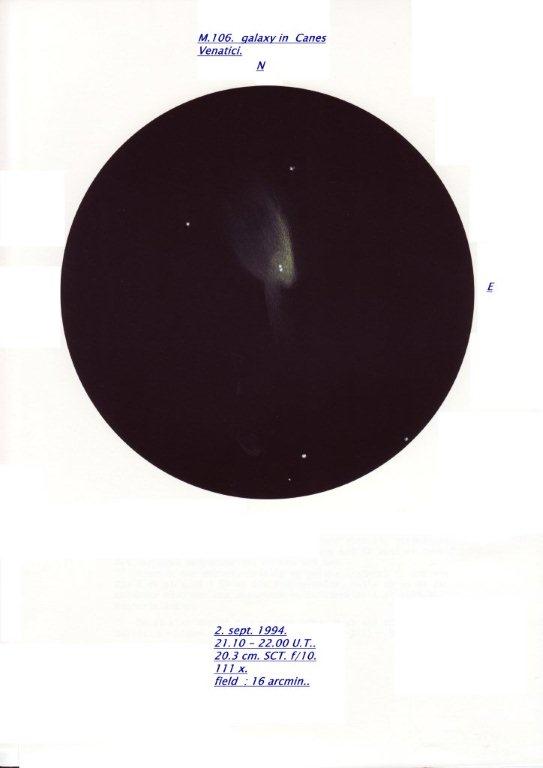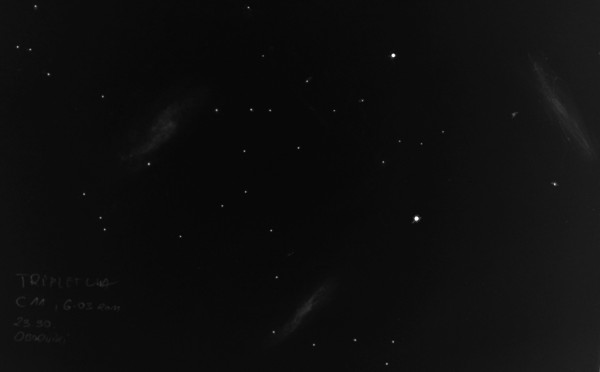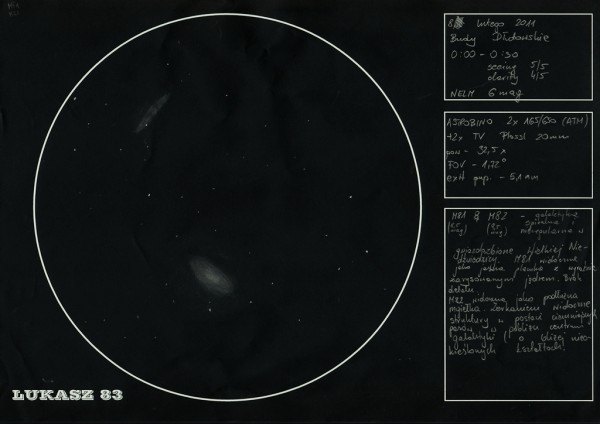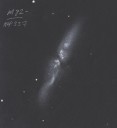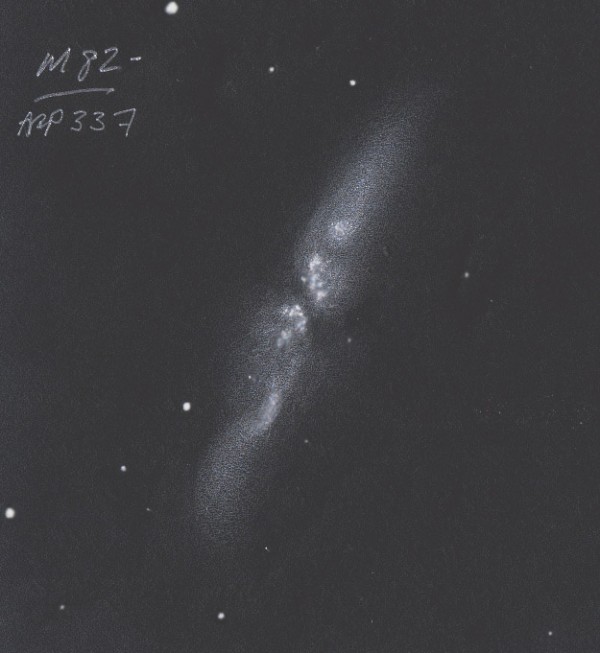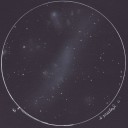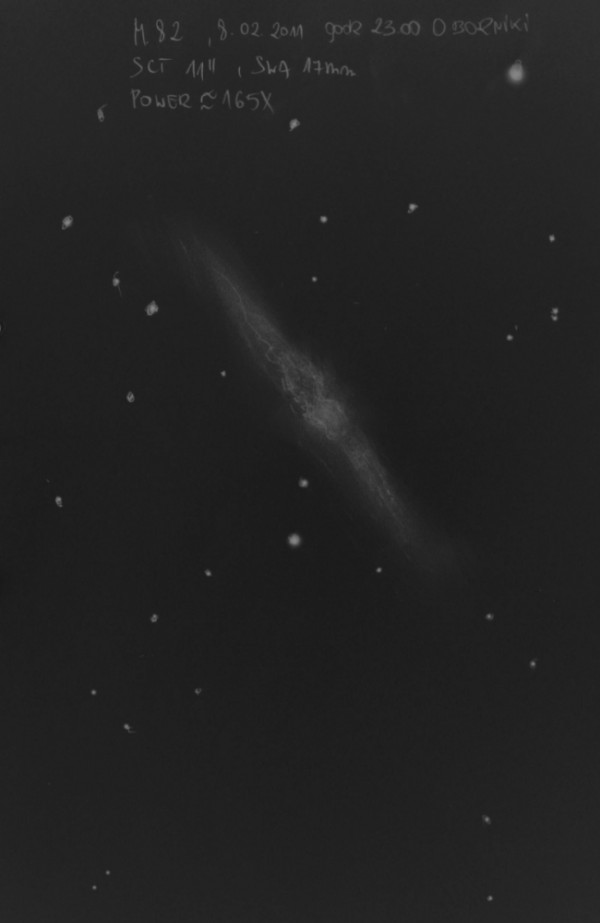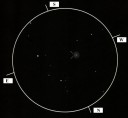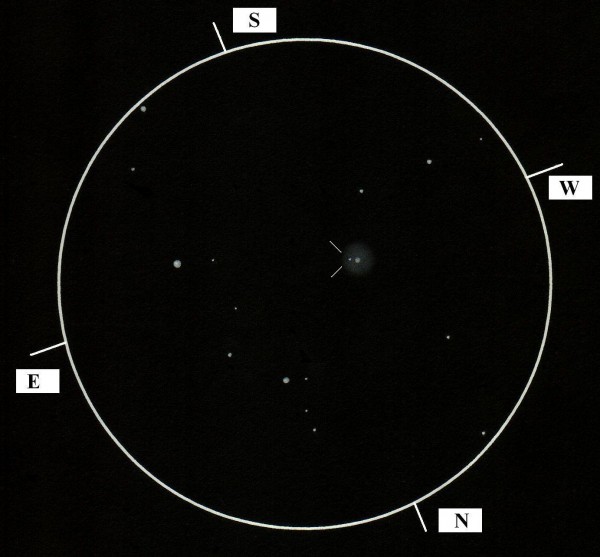Object: NGC 7479
Date: 2007 July
UT.: ?
Equipment: 500/4200 Optical Guidance Systems RC-telescope
Mag.: 171x
FOV: 18’
S = 7 / 10 T = 4 / 5
Observer: János Gábor Kernya
Location: Astronomical Observatory, Baja, Hungary
Category: Galaxy
Spiral Shiner
Hello,
Here is a recent sketch, M 64.
object name : M 64, Black eye galaxy
Object type: spiral galaxy
Location: Carrefour de Pecqueuse, 45 km of Paris, the Light Town !
Date 07/04/2011
Media : 2H and HB graphite pen, white paper.
Little photoshop gaussian blur
Dobson 406/1800 GSO
Ethos 10 mm
Regards,
Nicolas Zannin
Galaxy with a Grand Design
NGC 2997
Galaxy
Antlia
01/01/11
Iford NSW Australia
56cm f5 dobsonian telescope
Field: 27′
Magnification: 218x
Sky quality meter reading: 21:70
Black Canford paper
White pen
White pastel pencil
White pastel chalk
Blending stump
Paint brush
NGC 2997 has a certain sentimental value for me. Many years ago when I
first got a chance to look through a large dobsonian telescope it just
happened to be the first galaxy
that I was able to see spiral structure in, goes to show that on some
occasions there is no substitute for sheer aperture.
The only drawback with trying to sketch this elegant galaxy from my
location is that when it is at the zenith it is right up in Dobson’s
hole, making for some very
precarious conditions for sketching atop my observing platform.
Despite the balancing act the sketch came out reasonably well. Subtle,
somewhat large and diffuse spirals can be tricky to portray accurately.
NGC 2997 was discovered by William Herschel in 1793, and it lies about
25million light years away.
The plane of the galaxy from our vantage point is about 45°, so imagine
the view if it was directly face on.
Scott Mellish
Hey Artists!
I send you my sketch of the galaxy M. 106 in Canes Venatici.
This is an easy and unusual object with a bright northern arm and a faint and diffuse
one to south.
To me, the nucleus looked bright with two parts.This was a really interesting object.
I used crayons (watercolour) on black paper. More info on my sketch.
The observation was made outside Trondheim, Norway.
Thanks for all nice comments on my sketches!
Clear sky to all !! Per-Jonny Bremseth.
Treasures of a Lion
The Leo Triplet – three galaxies M65, M66, and the NGC 3628.
It is a small group of galaxies located about 35 million light years away from Earth
Apparent Magnitude of the members is from 9,3 -10,4mag
March 6, 2011- I saw them in SCT 11″ (power of about 70x), in the Swan 40mm, with field of view 72 degrees !
The NELM was about 5 mag, sky was very clear.
These objects like magnification, if we had used it, the Triplet would have shown us a lot of details.
Yours sincerely Robert
Object Name: The Leo Triplet
Object Type (galaxies)
Location (Oborniki, suburbia, Poland)
Date (06-03-2011)
Equipment: 11″ Schmidt ; Cassegrain on CGEM, WO SWAN 40mm
Autor: Ignisdei (Robert Twarogal)
Somewhere in Big Bear
Hi,
In attachment you can find sketch of famous pair of galaxies M81 & M82
Short description:
Object Name M81 – spiral galaxy & M82 – spiral galaxy with bar. Both in Ursa Major
Object Type galaxies
Location Budy Dłutowskie – small village in central Poland
Date 08.02.2011
Media graphite pencil, white paper, color invert
Telescope ATM ATROBINO (two Newtonians 165/650) + two TV Plossl 20mm eyepieces
Seeing 5/5
Transparency 4/5
NELM 6 mag
This time I have some kind of classic 🙂 Famous galaxies M81 & M82 in Ursa Major.
I observed it through the ATM ASTROBINO (two connected newtonians 165/650). It is great instrument for this kind of objects under dark sky.
Both galaxies were clearly visible with some details in Cigar (some “shadows” in the structure) . M81 – disk with brighter core, no more details observed.
Clear sky
Łukasz
Exploding with Detail
M82 is also cataloged as Arp 337, which is a good indication that there’s something unusual about its shape and means that interesting things are going on here. Indeed, it’s an especially vigorous starburst galaxy and has a bi-polar outflow from it core region that’s clearly depicted in many high quality images. This galaxy has a high surface brightness and is well seen in almost (any) size telescope, but the outflow is difficult to see except in silhouette to the brighter galaxy in the background. I was fortunate to have a particularly nice view of this energetic galaxy on February 25, 2011, and what follows is an account of my observation and sketch:
A rare clear February night – on a Friday no less – graced Oregon skies on the 25th so I headed out to my good friend Chuck’s place in the Coast Range mountains west of Portland for a few hours of observing. When I got there I was treated to a pristine, unspoiled and completely overcast sky – what?! It was perfectly clear when I left home for crying out loud! A solitary cloud sprang up right over Chuck’s place late in the day, and even though I saw it forming I was sure it would clear off by dark. Nope.
After waiting a couple of hours the sky started to clear. Feeling optimistic I set up my 28 inch f/4 scope – Chuck’s scope was already patiently waiting under a tarp – and by the time I was ready the sky was 100% clear. Sometimes we get lucky! There was about 4 or 5 inches of snow except on the gravel driveway – fortunately the snow there had melted earlier in the day.
After trying out my new DGM NPB filter on M42 – most excellent – I eventually settled on sketching M82. The conditions were quite nice with surprisingly good transparency and seeing. SQM readings were in the 21.25 to 21.35 range for most of the night. Temperatures fell slowly until a low of 17F at 2am when we called it a night. The Moon was coming up about then and revealed high clouds covering most of the sky, so we had gotten the best part of the night. More good luck.
As soon as I got M82 in the scope it was immediately apparent how good the conditions were because the galaxy was “exploding” with detail. I kept putting on more magnification, and until I got to 816x I kept seeing more internal detail. Most of my sketch was done at 408x and I used higher powers to help confirm some of the smaller and more difficult details. The most pleasing view was at 408x anyway so I really enjoyed the process of making this sketch. Chuck came over and soaked in the view for a while and agreed it was one of the better views he’d had of M82 too.
As always, I saw more than expected simply because I put a good effort into sketching. I don’t recall seeing the small details near the core on either side of the dividing central dark lane before but they sure stood out well tonight. I was also surprised how little the NPB and OIII filters dimmed this galaxy. The filters didn’t reveal other details, M82 just didn’t dim as much as most galaxies do.
The sketch is a result of about 90 minutes active drawing at the eyepiece and then I cleaned it up a bit the next day before inverting it. I used an HB lead pencil and an eraser for the original sketch. I tried a slight variation of my usual technique – I had a piece of stiff cardboard behind the page of my notebook I was drawing in and that gave me a little more control over my sketch. I’m impressed by the result because the raw sketch was much nicer looking in the light of day then normal. It could be a fluke, but I’ll keep at it until I know for sure.
Howard Banich
The Large Magellanic Cloud
The Large Magellanic Cloud
Dorado/Mensa
01/02/11
Ilford NSW Australia
Televue 76mm Apo refractor
Field: 317′
Magnification: 31x
Sky quality meter reading: 21:77
Black Canford paper
White pen
White pencil
Paint brush
White pastel chalk
White pastel pencil
If there is ever an excuse to expound the virtues of a fine quality rich field refractor, then a wide field panorama of the LMC would have to be it.
I have had a number of people just “blown away” by the experience of virtually capturing the entire vista of this magnificent dwarf galaxy in the one field that
I decided whenever the time was right, I will have to attempt a sketch.
The 31mm Nagler I used for this effort was almost as big as the telescope, but the view it gives is a truly noble experience.
At the top of the sketch and very conspicuous is the Tarantula Nebula (NGC 2070).
The rest of the field is strewn with a plethora open clusters and nebulosity to numerous to mention here.
The sketch took quite some time to complete and was very tedious.
However it can never replace the actual visual splendor of this object.
The Large Magellanic Cloud was first mentioned in literature as far back as 964AD.
Amerigo Vespucci recorded observations of it in 1503-04.
Ferdinand Magellan during his voyage in 1519 noted it, and it now bears his name.
The LMC was home to supernova 1987A, the only naked eye supernova visible for over 400 years.
Scott Mellish
The Big Cigar
Hi!
Messier 82 (the Cigar) is the smaller member of the Bode’s Galaxy pair.
About 600 million years ago a Cigar ‘s brother (M81 Galaxy) destroyed
regularity of the galactic-structure, by his strong gravity
Due to their proximity a millions of stars explode as supernovae,
ejecting a huge quantity of matter in the tens of thousands light years
away,
Las night I saw this deformed galaxy with magnification 165 x. The Cigar
like high power and need a good seeing and contrast. So I used 11
“Schmidt – Cassegrain on CGEM mount and the Sky-watcher eyepiece.
This sketch represent more than 40 minutes of staring at the white line
in the dark.
Yours sincerely Robert
Object Name: The Big Cigar
Object Type (Galaxy)
Location (Oborniki, suburbia, Poland)
Date (08-02-2011)
Equipment: 11” Schmidt – Cassegrain on CGEM, SWA SW 17mm
Autor: Ignisdei (Robert Twarogal)
